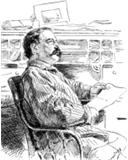
| The |  |
Papers |
|---|
Samuel Gompers traveled in very diverse circles over his long career: He played a role in every major labor fight from Haymarket, to Pullman, to the Railroad Shopmen's strike of 1922. He championed women's rights, public education, and a government more in touch with the needs of common citizens. He vehemently opposed child labor, prohibition, bolshevism, and anything that smacked of compulsion. And he had the ear of every president from William McKinley to Calvin Coolidge, brain stormed with Herbert Hoover over questions of technology and unemployment, and worked closely with legislators, industrialists, and social reformers of all kinds to spread the word that labor's rights were human rights.
So his papers (which include correspondence, newspaper articles, government documents, cartoons, photographs, and the like) not only shed light on the rise of trade unionism, but put a very human face on historical developments like industrialization, immigration, and urbanization, and on issues of the day including racism, women's rights, and political strategies for change.
In twelve indexed and annotated volumes, The Samuel Gompers Papers presents history from the bottom up – documents capture the voices of unskilled immigrants working 12 hour days, of mothers desperate to keep their families together while their husbands are on strike, of enthusiastic radicals raring to challenge the status quo, and of exhausted organizers, tarred and feathered and run out of town for daring to preach the gospel of unionism. Through these documents students can see first hand the human implications of developments like electricity in the home, the factory, and the community, and the practical impact of policies like protective tariffs, mechanization, scientific management, and unlimited immigration.
In the process, they will better understand the high social cost-of-living in an age of industrial capitalism and see for themselves how working- and middle-class people tried to improve their lives inside and outside the factory. Anyone interested in efforts to prohibit tenement work, to get children out the mills and into school, to “Americanize” recent immigrants, or to achieve the eight-hour day, for instance, can find plenty of useful primary documents in The Samuel Gompers Papers. And anyone interested in authentic female and black working-class voices, sometimes loud and strong as grass-roots organizers, sometimes angry as critics, and sometimes broken as victims of abuse and exploitation, will find plenty to work with here. MORE
Labor History
SG Biography
SG Quotations
AFL
Knights of Labor
IWW
Time Line
The SG Papers
The Project
Book Edition
Documents
Microfilm Edition
To Order
Research Tools
Bibliography
Index to Volumes
Micro Reel Lists
Subject Guides
Labor Links
Glossary
Contact Us
Home
WEB Accessibility